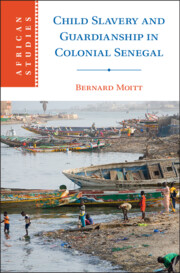Book contents
- Child Slavery and Guardianship in Colonial Senegal
- African Studies Series
- Child Slavery and Guardianship in Colonial Senegal
- Copyright page
- Dedication
- Contents
- Map of Senegal
- Figures
- Tables
- Preface
- Acknowledgments
- Introduction
- 1 Urban Senegal in the Second Half of the Nineteenth Century
- 2 The Evolution of Tutelle
- 3 Adoption of Minors and State Control of Tutelle
- 4 Legislating Guardianship, 1848–1900
- 5 Juvenile Labor, 1849–1905
- 6 The Crisis of 1903 and 1904
- 7 Minors in Institutions
- 8 Marriage, Life, Death, and Abuse
- Conclusion
- Bibliography
- Index
- African Studies Series
8 - Marriage, Life, Death, and Abuse
Published online by Cambridge University Press: 19 October 2023
- Child Slavery and Guardianship in Colonial Senegal
- African Studies Series
- Child Slavery and Guardianship in Colonial Senegal
- Copyright page
- Dedication
- Contents
- Map of Senegal
- Figures
- Tables
- Preface
- Acknowledgments
- Introduction
- 1 Urban Senegal in the Second Half of the Nineteenth Century
- 2 The Evolution of Tutelle
- 3 Adoption of Minors and State Control of Tutelle
- 4 Legislating Guardianship, 1848–1900
- 5 Juvenile Labor, 1849–1905
- 6 The Crisis of 1903 and 1904
- 7 Minors in Institutions
- 8 Marriage, Life, Death, and Abuse
- Conclusion
- Bibliography
- Index
- African Studies Series
Summary
Flight and other aspects of life in tutelle, such as marriage, abuse, and death, are taken up in Chapter 8. The chapter analyzes flight from the 1870s. Many minors fled after alleging mistreatment by their guardians. Others absconded to rid themselves of unhappy circumstances. The legal authorities normally acted and launched searches, often to no avail. Guardians generally disregarded the laws and regulations governing guardianship with impunity, including the requirement to notify the authorities when leaving Senegal with their wards. Some moved to other parts of Senegal; others to other parts of Africa; still others to France, temporarily or permanently. Although guardians had the upper hand in their dealings with minors and prevailed with the administration, the latter lodged complaints against them for poor treatment, deprivation, and abuse with police commissioners. Guardians often kept wards in tutelle well beyond the age of eighteen. While in tutelle, some wards, mostly females, got married following proposals mainly from newly emancipated slaves, predominantly Tirailleurs Sénégalais. In all cases, guardians took charge, made the arrangements, and notified the authorities. The chapter ends with the death of liberated minors in tutelle in both Senegal and France.
- Type
- Chapter
- Information
- Child Slavery and Guardianship in Colonial Senegal , pp. 177 - 201Publisher: Cambridge University PressPrint publication year: 2023

